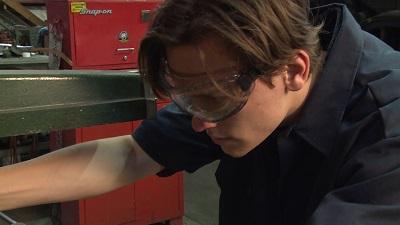How Does An Occupational Eye Injury Happen?
An occupational eye injury is a type of injury that can cause significant long-term problems. When an eye is injured, it can lead to severe visual impairment, affecting both your work and social life. Industries that put workers at risk for injury due to poor vision are construction, mining, utility work, and shipping.
Eye injuries are often caused by the following:
- Objects flying through the air such as wood, metal, plastic, stone fragments, and sparks
- Splashes from unsafe chemicals, including acids and corrosives, and molten metal
- Swinging or dangling items such as chains or ropes
- Electrical arcs and sparks
- Dust, fumes, mists, gases, vapors, or other particles in the air
- Radiant energy from welding, cutting, lasers, and ultraviolet or infrared light
Methods of injury:
Striking or scraping: Most injuries occur from small particles or objects striking or scraping the eye, such as dust, cement chips, metal slivers, and wood chips. These materials are often ejected by tools, windblown, or fall from above a worker. Large objects may also strike the eye or face, or a worker may run into an object causing blunt-force trauma to the eyeball or eye socket.
Penetration: Sharp objects like nails, staples, or slivers of wood or metal may penetrate the eyeball and result in a permanent loss of vision.
Chemical and thermal burns: Industrial chemicals or cleaning products are common causes of chemical burns to one or both eyes. Thermal burns to the eye also occur, often among welders. These burns routinely damage workers’ eyes and surrounding tissue.
Providing The Right Equipment For Your Employees
Providing the right equipment for your employees will have a direct impact on their safety and productivity.
To choose the eye protection that is appropriate for the work you do, you need to:
- Understand the eye hazards you may encounter.
- Know what types of personal protective equipment (PPE) will most effectively shield you from those hazards.
To protect your eyes from flying and falling objects, safety glasses are a simple but effective solution.
- They can also help protect you from any eye hazards you may encounter.
Safety glasses use shatter-resistant lenses that are made of glass, plastic, or polycarbonate.
All eye personal protective equipment, including goggles, safety glasses, and face shields, should comply with or exceed the test requirements of ANSI Z87.1-1989.
In windy and dusty conditions, or when you’re performing tasks such as hammering, grinding, sawing, or sanding, tiny particles of dust, sand, sawdust, bits of metal, or other substances can fly toward your eyes from almost any direction.
- While safety glasses with side shields can give you some protection, goggles provide complete protection from these particles.
- Their eyecups fit snugly over the eye area.
Goggles can be rigid or flexible, with clear or shaded lenses, allowing for ventilation in different ways.
When flying particles create hazards to the face and the eyes, face shields give more coverage than glasses or goggles.
- But face shields alone cannot provide sufficient eye protection.
- Safety glasses or goggles should always be worn under them.
Splashes of gasoline, solvents, cleaners or other liquids can cause severe burns or further damage if they get into your eyes.
Goggles and face shields should be worn to protect your eyes and face when you’re working with these substances.
- Liquids can get through the ventilation holes of regular goggles.
- Be sure to wear ones that use indirect ventilation that will keep liquids out.
Remember, you can’t work safely if you can’t see clearly, so keep the lenses of your protective eyewear clean.
- Replace scratched, broken, or poorly fitting eyewear as soon as possible.
If you have questions about what type of eye protection is proper, talk to your supervisor or safety manager.
If you’ve ever had a sunburn, you already know what the ultraviolet radiation in sunlight can do to your skin.
Ultraviolet (known as “UV”) and infrared radiation (known as “IR”) can both be hazardous to your eyes as well.
- When radiation heats and burns the surface of your eyes, the result can be a painful temporary condition called “conjunctivitis”.
- When IR and UV get inside the eyeball, they can burn nerve tissue, and that damage is potentially permanent.
When you’re working in the sun, remember to shield your eyes with sunglasses or tinted goggles.
- Each pair is marked with the amount of UV protection that it gives you.
- Wear eyewear that provides 100% protection.
Remember that polarized lenses only filter out glare, and will not protect you from UV radiation.
The torch flames and electrical arcs used in welding give off significant amounts of glare, UV, and IR.
- These hazards can affect not only the welders themselves but anyone working nearby as well.
Welders can protect themselves by wearing welding goggles or helmets with special filters to shield their eyes from this dangerous “radiant energy.”
- Filters composed of shaded glass provide a fixed level of protection.
- Some filters are designed to automatically darken as they are exposed to IR or UV radiation.
All lenses use standard “filter numbers” to indicate how much protection they can give you.
- The higher the filter number, the greater the protection.
Different types of welding emit different levels of glare and radiation.
- Goggles appropriate for oxy-fuel welding cannot shield you from the higher levels of ultraviolet and infrared radiation produced by electrical welding.
Welders are required to set up welding screens before they start their work to protect people who are working nearby from ultraviolet and infrared radiation
- In certain situations, they might provide bystanders with tinted goggles or other protection as well.
—
To learn more about eye safety protection, please view the free demonstration of our eye safety training course.










